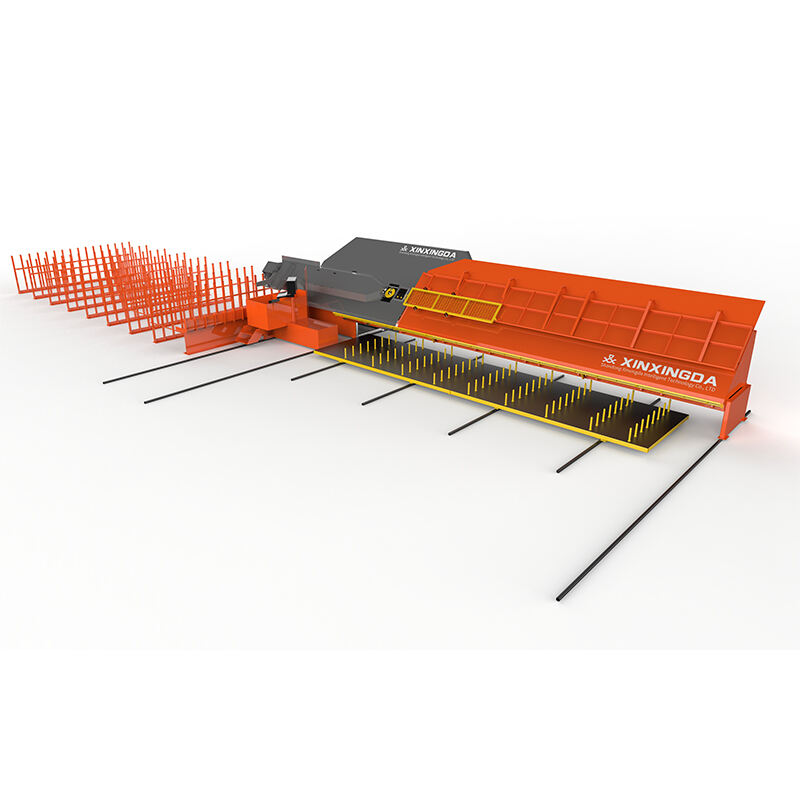In the modern construction and manufacturing landscape, precision and efficiency are paramount when working with heavy-duty metal fabrication projects. A large-scale bending machine represents a critical investment for facilities handling substantial volumes of rebar, structural steel, and other construction materials. Understanding the essential features that distinguish reliable equipment from inferior alternatives can significantly impact operational productivity, project timelines, and overall profitability. The construction industry demands machinery that delivers consistent performance under demanding conditions while maintaining precise specifications across thousands of bending cycles.
Structural Engineering and Frame Design
Heavy-Duty Frame Construction
The foundation of any reliable large-scale bending machine begins with its structural integrity. Premium machines feature reinforced steel frames constructed from high-grade materials that resist deformation under extreme operational loads. The frame design must accommodate the substantial forces generated during bending operations while maintaining dimensional accuracy throughout the machine's service life. Quality manufacturers utilize computer-aided design and finite element analysis to optimize frame geometry for maximum strength-to-weight ratios.
Advanced frame configurations incorporate strategically placed reinforcement ribs and stress distribution channels that prevent fatigue failures in high-stress areas. The welding quality of frame components directly influences long-term reliability, with precision welding techniques ensuring consistent joint strength across all connection points. Superior frame designs also feature modular construction that facilitates maintenance access and potential future upgrades without compromising structural integrity.
Vibration Dampening and Stability
Operational stability during high-volume production runs requires sophisticated vibration control systems integrated into the machine's foundation design. Quality large-scale bending machines incorporate isolation mounts and dampening mechanisms that minimize vibration transmission to surrounding equipment and facility structures. This vibration control directly impacts bending accuracy and extends component service life by reducing wear on moving parts.
The machine's center of gravity and weight distribution play crucial roles in maintaining stability during operation. Well-engineered designs position heavy components low in the frame structure while ensuring balanced load distribution across the machine's footprint. This careful weight management prevents machine movement during operation and reduces the need for extensive foundation preparation.
Power Systems and Drive Mechanisms
Hydraulic System Performance
The hydraulic system represents the heart of most industrial large-scale bending machines, providing the power and precision necessary for consistent material deformation. Premium hydraulic systems feature oversized pumps and reservoirs that maintain consistent pressure throughout extended operating cycles. The hydraulic fluid cooling and filtration systems prevent contamination and temperature-related performance degradation that can compromise bending accuracy.
Advanced pressure control valves and flow regulation systems enable precise force application during bending operations. These systems incorporate feedback mechanisms that automatically adjust hydraulic pressure based on material resistance, ensuring consistent bend angles regardless of material variations. Quality hydraulic components also feature predictive maintenance capabilities that monitor system performance and alert operators to potential issues before failures occur.
Motor and Transmission Integration
The drive motor and transmission system must deliver reliable torque transfer while accommodating the variable load conditions encountered during different bending operations. Premium machines utilize servo motors with integrated encoders that provide precise positional feedback and enable accurate bend angle control. The transmission system design balances speed and torque requirements while minimizing backlash that could affect bending precision.
Energy efficiency considerations increasingly influence motor selection for large-scale operations. Modern machines incorporate variable frequency drives that optimize power consumption based on operational requirements. These systems reduce energy costs while extending motor service life through reduced thermal stress and improved operational efficiency.
Control Systems and Automation Features
Programmable Logic Controller Integration
Contemporary large-scale bending machine systems rely on sophisticated programmable logic controllers that manage complex bending sequences and safety protocols. These control systems store multiple bending programs and enable rapid changeover between different production requirements. The user interface design significantly impacts operational efficiency, with intuitive touchscreen displays providing clear feedback on machine status and production parameters.
Advanced control systems incorporate real-time monitoring capabilities that track production metrics, material consumption, and equipment performance indicators. This data collection enables predictive maintenance scheduling and optimization of production workflows. Integration with facility management systems allows for centralized monitoring of multiple machines and coordinated production planning.
Safety and Emergency Response Systems
Comprehensive safety systems represent non-negotiable features for reliable large-scale bending equipment. Modern machines incorporate multiple safety barriers including light curtains, pressure-sensitive mats, and emergency stop systems that immediately halt operations when safety violations are detected. The safety system design must balance operator protection with production efficiency, ensuring rapid recovery from safety stops without compromising worker safety.
Emergency response protocols include automatic system shutdown procedures that safely position machine components and secure hydraulic systems during power failures or emergency situations. Backup power systems may be necessary for critical safety functions, ensuring that emergency stops and position holding capabilities remain operational during power interruptions.

Material Handling and Positioning Systems
Automated Material Feed Mechanisms
Efficient material handling systems minimize manual intervention while ensuring consistent material positioning for accurate bending operations. Premium machines feature automated material feed systems that accommodate various material sizes and configurations without requiring extensive setup changes. These systems incorporate sensors and positioning controls that verify proper material placement before initiating bending cycles.
The material feed system design must accommodate the range of materials typically processed in large-scale operations. Adjustable guides and supports ensure proper material alignment while preventing damage to finished surfaces. Advanced systems include material measurement and cutting capabilities that integrate seamlessly with bending operations to reduce handling requirements.
Product Discharge and Collection
Automated product discharge systems maintain production flow while organizing finished components for subsequent processing or packaging. These systems must handle the variety of bent configurations produced during typical operations without damaging finished products. Conveyor systems and robotic handling equipment enable continuous operation without manual intervention for product removal.
Quality control integration at the discharge point enables automatic inspection and sorting of finished products. Vision systems and dimensional measurement equipment can verify bend angles and overall product quality before products enter the finished goods inventory. This automated quality control reduces manual inspection requirements while ensuring consistent product standards.
Maintenance Accessibility and Service Support
Component Access and Serviceability
Long-term reliability depends heavily on maintenance accessibility and component serviceability design. Quality large-scale bending machines feature strategically positioned access panels and service points that enable routine maintenance without extensive disassembly. The arrangement of hydraulic lines, electrical conduits, and mechanical components should facilitate inspection and replacement activities.
Modular component design enables efficient replacement of wear items and major components without affecting surrounding systems. Standardized fasteners and connection methods reduce the variety of tools required for maintenance activities. Clear component labeling and documentation support efficient troubleshooting and repair procedures.
Diagnostic and Monitoring Capabilities
Advanced diagnostic systems provide real-time monitoring of critical machine parameters and component conditions. These systems track hydraulic pressures, motor temperatures, vibration levels, and other performance indicators that signal potential maintenance requirements. Predictive maintenance algorithms analyze operational data to recommend optimal service intervals and component replacement schedules.
Remote monitoring capabilities enable service technicians to diagnose issues and provide support without on-site visits. This connectivity reduces downtime and enables proactive maintenance scheduling based on actual machine conditions rather than predetermined time intervals. Integration with manufacturer support systems provides access to technical expertise and replacement parts ordering.
FAQ
What capacity considerations are important when selecting a large-scale bending machine
Capacity selection requires careful analysis of maximum material dimensions, bending force requirements, and production volume expectations. Consider both current needs and anticipated future growth when evaluating machine specifications. The machine's duty cycle rating should accommodate peak production demands while maintaining consistent performance throughout extended operating periods.
How do environmental conditions affect large-scale bending machine performance
Environmental factors including temperature variations, humidity levels, and dust exposure significantly impact machine reliability and accuracy. Premium machines incorporate environmental protection systems and temperature compensation features that maintain performance consistency across varying operating conditions. Proper facility environmental controls extend equipment service life and reduce maintenance requirements.
What training requirements should be considered for large-scale bending machine operators
Comprehensive operator training programs should cover machine operation, safety protocols, routine maintenance procedures, and basic troubleshooting techniques. The complexity of modern control systems requires ongoing education to maximize operational efficiency and maintain safety standards. Regular training updates ensure operators remain current with equipment capabilities and best practices.
How can production efficiency be optimized with large-scale bending equipment
Production optimization involves careful attention to material flow, program setup efficiency, and maintenance scheduling. Automated material handling systems reduce cycle times while maintaining consistent quality. Regular analysis of production data identifies opportunities for process improvements and equipment upgrades that enhance overall operational efficiency.
Table of Contents
- Structural Engineering and Frame Design
- Power Systems and Drive Mechanisms
- Control Systems and Automation Features
- Material Handling and Positioning Systems
- Maintenance Accessibility and Service Support
-
FAQ
- What capacity considerations are important when selecting a large-scale bending machine
- How do environmental conditions affect large-scale bending machine performance
- What training requirements should be considered for large-scale bending machine operators
- How can production efficiency be optimized with large-scale bending equipment


